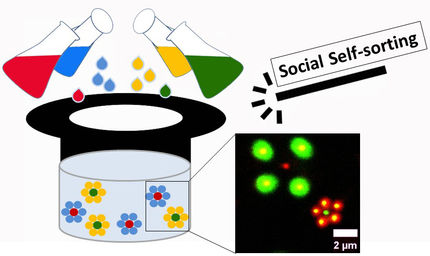Formation of swarms in nanosystems
Advertisement
One of the striking features of self-organization in biomolecular systems is the capacity of assemblies of filamentous particles for synchronous motion. LMU physicists now provide new insights into how such movements are coordinated.
Living matter, which consists largely of diverse polymeric structures assembled from various types of subunits, often exhibits striking behaviors, such as a capacity for self-organization and active motion. On an organismic scale, this type of collective motion is exemplified by the synchronous motions of flocks of starlings or geese, but it is also observed at the level of bacterial and animal cells. Physicists are interested in teasing out the elementary mechanisms that underlie the formation of such ordered structures and organized motions, with a view to gaining a deeper understanding of macroscopic phenomena. Dr. Christoph Weber and Professor Erwin Frey, who holds the Chair of Biological and Statistical Physics at LMU Munich, in collaboration with Dr. Ryo Suzuki and Professor Andreas Bausch at the Technical University of Munich (TUM), have chosen a model system based on filaments made up of subunits of the protein actin for their investigations. Actin microfilaments are involved in the active migration of nucleated cells and in intracellular transport processes. In their experiments the researchers first immobilize motor proteins by fixing them to a glass slide. When actin filaments were added together with a source of biochemical energy, they interacted with the motors and exhibited active gliding motions. Moreover, individual filaments were found to locally adopt strongly curved configurations, and the team analyzed their statistics, what happens when filaments collide and under what conditions interacting filaments exhibit collective, streaming motions. According to the most popular theory, the fact that thin actin filaments bend as they are propelled by motor proteins is attributable to random thermal fluctuations, i.e. Brownian motion. But this assumption is false, says Christoph Weber, who now works at the Max-Planck-Institute for the Physics of Complex Systems in Dresden. Brownian motion has only a very weak impact on the form of the filaments. Instead, as the Munich researchers show, the molecular motors are not only responsible for propelling the fibers, they also cause them to form strong bends. “The filaments exhibit a range of local curvatures, the statistical distribution of which is incompatible with thermally driven motion,” Ryo Suzuki explains.
The role of non-binary interactions
In addition, the researchers have shown that the assumption that the interactions in the system are always binary in nature is not sufficient to explain the fact that, at high densities, filaments can align with each other and begin to display directed, collective motions. In fact, simultaneous encounters involving multiple agents appear to be required to account for the emergence of such collective motion. In this case, the filaments, each of which is composed of multiple subunits, apparently remain in stable alignment with each other and interact not only pairwise, but also in a non-binary manner. In their experiments, the scientists observed that, depending on the density and the mean length of the filaments, a phase transition occurs in which a state of non-directed movements is abruptly transformed into one characterized by collective motions. From a theoretical point of view, this implies that the currently favored model for the motions of actively driven particles, which is based on the kinetic theory of gases, cannot adequately account for the behavior of such systems. Instead, it appears as if the filaments themselves act in a coordinated fashion, like molecules in a fluid state.
Original publication
Ryo Suzuki, Christoph A. Weber, Erwin Frey & Andreas R. Bausch; "Polar pattern formation in driven filament systems requires non-binary particle collisions"; Nature Physics; 2015
Christoph A. Weber, Ryo Suzuki, Volker Schaller, Igor S. Aranson, Andreas R. Bausch, and Erwin Frey; "Random bursts determine dynamics of active filaments"; PNAS, 2015



























































